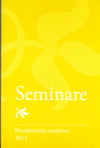Twórczość fortepianowa Mariana Sawy
Marian Sawa’s piano music
Author(s): Marcin T. ŁukaszewskiSubject(s): History
Published by: Towarzystwo Naukowe Franciszka Salezego (TNFS)
Keywords: Marian Sawa; Mazurka; Study; piano music; carol; neoclassicism; sacred music; folklore
Summary/Abstract: Marian Sawa (1937-2005), composer, organist, improviser and pedagogue, owes his reputation primarily to his prolific organ output (over 200 works for organ solo, including five concertos), choral music (several dozen compositions) and vocal-instrumental sacred music. Pride of place goes to Droga Krzyżowa (The Way of the Cross), Missa claromontana and works for organ: Witraże (Stained-glass), Ecce lignum crucis and Hymnus in honorem sancti Petri et Pauli. Works for piano are modest in number, less known and rather rarely performed but they are hardly of a marginal character. Marian Sawa’s piano output comprises a dozen or so pieces of diverse genres and styles. The earliest compositions, dating from Sawa’s studies at the State Higher School of Music in Warsaw, include Four Etudes, a cycle of Variations and the Prelude and Fugue, all in the neo-Classical style (1966-67). In the etudes the composer explored several problems, such as the technique of double stops and octaves. The later Toccata (1970) and Stylized Prelude (1975) are, by and large, the continuation of the same style. In the Toccata one can notice the genre’s characteristic features including the motoric drive, a sense of mobility and the repetitiveness of notes (similar effects can be found in toccatas by such composers as Bolesław Woytowicz and Sławomir Czarnecki). Sawa’s most interesting piano works date from the 1980s and 1990s, Scherzino (1983) and Four Mazurkas (1993/94) being the most frequently-performed pieces. Sawa’s output also includes compositions which draw freely on the sonata form: Sonatę Ha-Fis (Sonata B-Fsharp) for keyboard instruments (1995, the title refers to the two opening notes), Sonatina for harpsichord, piano or organ (1995) and arrangements of Polish Christmas carols. One of Sawa’s most spectacular pieces is the Fugue-Bolero for two pianos (1996), which is an arrangement of his earlier, highly popular version for organ. Three idioms can be distinguished in Sawa’s piano music: dance/folk, motoric/toccata and sacred. The first employs the dance forms popular in Polish folk music (mazurek, oberek, krakowiak), the rhythm pattern of the ‘mazur’ and bourdon fifths. The main features of the second idiom are the figurative texture, virtuosity, a sense of mobility and, in the majority of works (including those from the 1990s), references to the neo-Classical style. The sacred idiom manifests itself in the use of quotations from church songs. For example, in the Third Mazurka (1993) it is a quotation from the Polish church song to St Joseph, while the musical material of the Three Elegies (1995) is based on the religious song Ja wiem, w kogo ja wierzę / I know in whom I believe. These works are also renowned for their specific mood of meditation and contemplation, creating an aura of spiritual music. The arrangements of Polish Christmas carols also belong to this group (Four Christmas Carols for piano / four hands, 2003; Kolędowe granie / Playing the carols, 2004
Journal: Seminare. Poszukiwania naukowe
- Issue Year: 29/2011
- Issue No: 1
- Page Range: 317-335
- Page Count: 23
- Language: Polish

